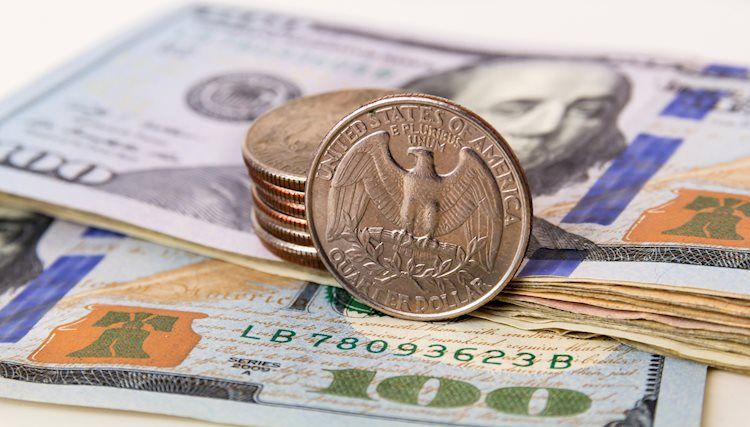- US Dollar corrects lower on Monday with the market bracing for a data-packed week in the US.
- Hopes of gradual Fed easing and speculation of a Trump win are buoying the USD.
- The US Dollar is on track to its best monthly performance in the last two years.
The US Dollar (USD), as measured by the US Dollar index DXY, opens the week in a softer tone as investors brace for an eventful week. The third quarter’s US Gross Domestic Product (GDP), the Personal Consumption Expenditures (PCE) Price Index, and the Nonfarm Payrolls (NFP) report are all out in the coming days.
The broader Dollar trend, however, remains positive as investors dial back hopes of aggressive interest rate cuts by the Federal Reserve (Fed). A raft of strong US economic data and speculation of former US President Donald Trump winning the US presidential election on November 5, with his inflationary policies, are lifting US Treasury yields and dragging the US Dollar higher.
Daily digest market movers: The US Dollar consolidates as investors await growth and labour data
- The Greenback is trading within the previous week’s range, near three-month highs, and on track to a 4% rally in October, on its strongest monthly performance in two years.
- The solid labour figures have consolidated the idea that the US economy is outperforming the rest of the major economies, which will force the Fed to slow down its easing cycle.
- The CME FedWatch tool is pricing a 96% chance of a 25 basis point (bps) cut next week. Two weeks ago, the market was split between a 25 or a 50 bps cut in November.
- The US economy is expected to show a steady 3% yearly growth in the third quarter. In the current global context, these are solid numbers, consistent with a tight labour market and steady inflation.
DXY technical outlook: DXY correction approaches a key support area at 103.95
The DXY index is gathering bearish traction, with price action approaching 104.95, where the 4-hour 50 Simple Moving Average (SMA) meets last Friday’s low. The 4-hour Relative Strength Index (RSI) indicator is showing bearish divergence, and US yields are pulling back, altogether suggesting that a deeper correction might be in progress.
A confirmation below 103.95, would increase pressure towards 103.45 (last week’s low), ahead of the 38.6% Fibonacci retracement, at 102.85 .Resistances are at the 104.55-104.80 range, and above here, at 105.20.
USD Index 4-hour chart
Fed FAQs
Monetary policy in the US is shaped by the Federal Reserve (Fed). The Fed has two mandates: to achieve price stability and foster full employment. Its primary tool to achieve these goals is by adjusting interest rates. When prices are rising too quickly and inflation is above the Fed’s 2% target, it raises interest rates, increasing borrowing costs throughout the economy. This results in a stronger US Dollar (USD) as it makes the US a more attractive place for international investors to park their money. When inflation falls below 2% or the Unemployment Rate is too high, the Fed may lower interest rates to encourage borrowing, which weighs on the Greenback.
The Federal Reserve (Fed) holds eight policy meetings a year, where the Federal Open Market Committee (FOMC) assesses economic conditions and makes monetary policy decisions. The FOMC is attended by twelve Fed officials – the seven members of the Board of Governors, the president of the Federal Reserve Bank of New York, and four of the remaining eleven regional Reserve Bank presidents, who serve one-year terms on a rotating basis.
In extreme situations, the Federal Reserve may resort to a policy named Quantitative Easing (QE). QE is the process by which the Fed substantially increases the flow of credit in a stuck financial system. It is a non-standard policy measure used during crises or when inflation is extremely low. It was the Fed’s weapon of choice during the Great Financial Crisis in 2008. It involves the Fed printing more Dollars and using them to buy high grade bonds from financial institutions. QE usually weakens the US Dollar.
Quantitative tightening (QT) is the reverse process of QE, whereby the Federal Reserve stops buying bonds from financial institutions and does not reinvest the principal from the bonds it holds maturing, to purchase new bonds. It is usually positive for the value of the US Dollar.
Read the full article here

